Welcome to our Colossus Movie Guide for The Shining. This guide contains everything you need to understand the film. Dive into our detailed library of content, covering key aspects of the movie. We encourage your comments to help us create the best possible guide. Thank you!
What is The Shining about?
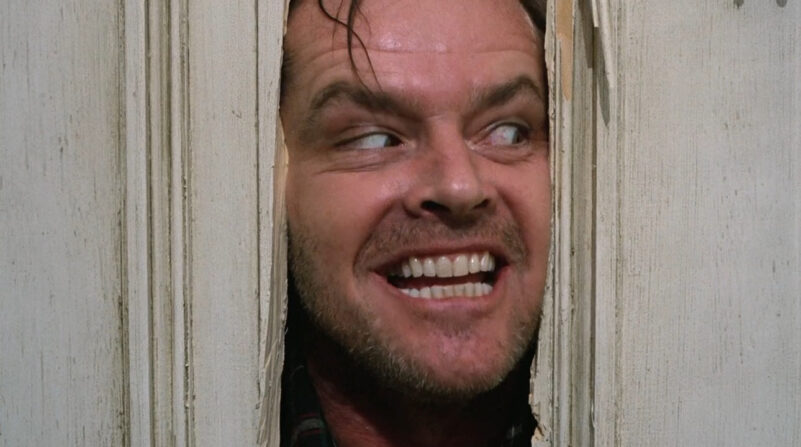
The Shining, an adaptation of Stephen King’s famous novel, is a chilling exploration of the human psyche and the inherent danger of isolation. It is the embodiment of a man’s descent into madness, fueled by the confines of a desolate, haunting environment, and the strain it exerts on familial relationships. The Overlook Hotel, a silent yet ominously omnipresent character, is the crucible where Jack Torrance’s sanity slowly dissolves, his inner demons manifesting as violent, paranoid tendencies. The labyrinthine corridors and the eerie vastness of the hotel mirror Jack’s increasing disconnection from reality, his confusion and desperation.
More subtly, Stanley Kubrick’s horror movie tackles the cycle of violence, be it domestic or historical. The concept of “shining,” or having a deep, psychic connection with the world and its past, exposes Jack’s son Danny to the hotel’s sinister history, suggesting a recurring pattern of violence. This could be seen as a critique of society’s inability to break away from past atrocities, forever doomed to repeat them. On a personal level, it also reflects on the domestic horror inflicted by Jack on his own family, mirroring the sins of the fathers visiting upon the sons.
The Shining takes us on a terrifying journey, not just through a haunted hotel, but into the darker corners of human nature, making us question our perceptions of reality, history, and the bonds that hold a family together.
Movie Guide table of contents
Cast
- Jack Nicholson – Jack Torrance
- Shelley Duvall – Wendy Torrance
- Danny Lloyd – Danny “Doc” Torrance
- Scatman Crothers – Dick Hallorann
- Barry Nelson – Stuart Ullman
- Philip Stone – Delbert Grady
- Joe Turkel – Lloyd
- Anne Jackson – Doctor
- Tony Burton – Larry Durkin
- Diane Johnson – Writer
- Stanley Kubrick – Writer and director
The ending of The Shining explained
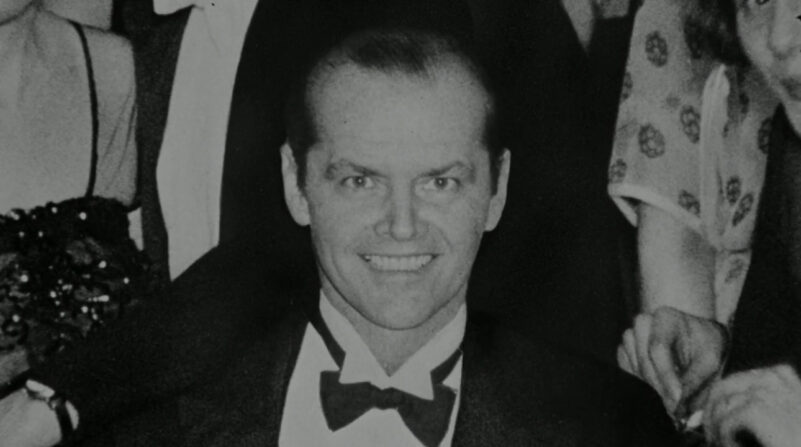
A recap of The Shining‘s ending
As The Shining hurtles towards its climactic conclusion, the tension in the Overlook Hotel reaches a fever pitch. Jack’s descent into madness is complete. He’s no longer the man who arrived at the hotel with his family. Instead, he has transformed into a deranged murderer, intent on fulfilling the macabre legacy of violence in the hotel.
The climax begins when Jack, driven by the malevolent forces of the Overlook, takes up an axe and begins to stalk his family through the hotel. His wife Wendy, terrified but determined, manages to fend Jack off momentarily and escapes with Danny, but not before knocking Jack out with a baseball bat and locking him in the pantry.
Wendy tries to escape with Danny, but cannot because Jack has sabotaged the hotel’s two-way radio and snowcat. Danny begins to repeat the word “redrum” and then writes it in the mirror. In this moment, Wendy realizes the word is “murder” spelled backwards.
Soon, Jack is released by the ghostly apparition of Delbert Grady, the former caretaker who murdered his own family. Free again, Jack resumes his murderous pursuit. By this time, the hotel’s cook, Dick Hallorann, who also possesses the “shine” and had sensed trouble at the Overlook, arrives to help. He is murdered by Jack upon entering the hotel.
Meanwhile, Danny, who has been evading his father, runs into the hotel’s hedge maze in a bid to escape. Despite Jack’s best efforts to find him, Danny manages to trick his father by walking backwards in his own footprints before jumping to the side and covering his tracks. This leaves Jack wandering in the maze, disoriented and confused.
Danny manages to escape the maze and reunites with his mother, Wendy. The two find Hallorann’s snowcat, a vehicle he used to get to the Overlook, and use it to escape the hotel’s horrifying grasp. In the final moments of Kubrick’s film, we see Jack, lost and freezing in the maze. Overcome by the cold, he eventually collapses and dies, his frozen face bearing a chilling testament to the horrifying ordeal.
The last scene of the film takes us back into the hotel, towards a wall adorned with photographs from the hotel’s past. We zoom in on a photo from a 1921 ball, and there in the crowd, smiling, is Jack, as if he has been part of the hotel’s history all along.
The meaning of The Shining‘s ending
In the broader context of The Shining‘s themes, the ending encapsulates the struggle against inherited violence and the attempt to escape its repetitive cycle. It underscores the dangers of ignoring or failing to reconcile with past atrocities, and hints at the potential for both the continuation and interruption of destructive patterns.
Through its layers of symbolism and narrative implications, the ending of The Shining leaves the audience with plenty to ponder, long after the credits roll. The resonance of its closing scenes, like the echo of a chilling laughter in the empty halls of the Overlook Hotel, serves as a testament to the film’s powerful exploration of human nature and history’s haunting echoes.
Now let’s discuss some of the ending’s more intimate details.
The Maze
Throughout The Shining, the Overlook Hotel functions as a symbolic maze—a labyrinth of haunting memories, past atrocities, and malevolent energies. Its corridors echo with historical violence, its rooms teem with specters of its blood-soaked past. It’s a place that twists and turns around its inhabitants, slowly disorienting them, just like a real maze. The hotel’s psychic labyrinth mirrors the mental disarray and chaos that Jack succumbs to, as he’s led deeper into his own mental maze of madness, manipulated by the violent history of the hotel.
Contrasting this symbolic maze is the literal one, the hedge maze, where the film reaches its climax. This physical labyrinth embodies the confusion, fear, and disorientation that the characters have experienced within the Overlook Hotel. But unlike the symbolic maze, it also becomes the site of liberation. Danny uses his wit and bravery to outsmart his deranged father and escape, thereby symbolically conquering the labyrinthine horrors of the Overlook Hotel.
The literal maze brings thematic resolution to the film by symbolizing the possibility of escape from inherited cycles of violence. It illustrates the power of confronting the maze-like complexities of history, trauma, and violence, and navigating through them successfully. The survival and escape of Wendy and Danny from both the hedge maze and the Overlook Hotel underscore a potent message: the cycle of violence (an important theme discussed in the Themes and Meaning section), while daunting and complex, is not inescapable. It’s a triumphant, albeit haunting, resolution to the film’s exploration of history’s violent echoes and the human capacity to endure and survive. This contrast between the hotel’s symbolic maze and the literal one amplifies the film’s thematic depth, enhancing its narrative resonance.
The Photograph
The enigmatic 1921 photograph, displaying Jack as an attendee at a lavish Overlook Hotel party, serves as a chilling conclusion to The Shining. This image, intriguing and unsettling, captures one of the film’s central themes: the inescapability of history and its insidious impact on the present.
The photograph suggests that Jack has become part of the hotel’s legacy of violence, further accentuating the cyclical nature of the destructive patterns explored throughout the movie. The visual implication that Jack has always been a part of the hotel’s history is symbolic of the film’s exploration of inherited evil and repetitive violence. It underscores the idea that the consequences of past atrocities linger, even when those who perpetrated them are long gone.
By revealing Jack’s image in the photograph, the film ingeniously ties the personal narrative of its protagonist to the broader historical narrative of the Overlook Hotel. It suggests that Jack’s descent into madness wasn’t an isolated incident but a repetition of the hotel’s violent history. This clever cinematic twist serves to emphasize the enduring, haunting power of past violence and its capacity to ensnare present and future generations.
Yet, while this image brings an eerie resolution to Jack’s storyline, it simultaneously raises questions about the fate of Wendy and Danny. If Jack, despite his death, is trapped within the cycle of violence as suggested by the photograph, what does this imply for his wife and son, who have escaped the hotel’s immediate threat?
Ultimately, the final shot of the 1921 photograph does not offer a comforting resolution. Instead, it extends the film’s thematic exploration beyond its immediate narrative, leaving the audience with lingering questions and interpretations. In doing so, it underscores the complexities inherent in breaking cycles of violence, hinting at the enduring struggle that survivors may face in their quest for true liberation from a violent past.
Redrum
“Redrum,” the reversed form of “murder,” is a critical element of The Shining and provides a crucial turning point towards the film’s terrifying climax. Danny’s utterance of this word is a symbolic and literal harbinger of the impending violence that’s about to unfold in the Overlook Hotel.
The reversed spelling and Danny’s cryptic introduction of it mirror the unsettling, disorienting atmosphere of the hotel. It suggests that something is awry, a hidden danger is lurking beneath the surface of apparent normalcy. The backward nature of “redrum” is reflective of the backward glance into history that the hotel demands, uncovering the concealed violence and horror that have permeated its past.
The timing of the “redrum” revelation is noteworthy. It happens when Jack’s descent into madness is near complete and the safety of Wendy and Danny is under severe threat. As such, it acts as a chilling prophecy of imminent danger, a forewarning of the terrifying transformation of their husband and father into a would-be murderer.
But why does Danny say it backward? One interpretation might be that it’s an insight into how Danny perceives and processes the world around him. His psychic abilities, or his “shine,” allows him to perceive things others can’t, but these premonitions come to him in a distorted, disorienting manner, much like the confusing and disconcerting nature of “redrum.” It’s a testament to his unique worldview and his struggle to comprehend and communicate the horrors he senses.
Thematically, “redrum” underscores the film’s exploration of inherited violence. It’s through Danny, the innocent child, that the echo of the hotel’s murderous history comes to light. In this sense, “redrum” becomes a symbol of the legacy of violence being passed on to younger generations. Its revelation is a chilling reminder of the horrors children might inherit and bear witness to, thereby highlighting the necessity of breaking violent cycles for the sake of future generations.
The themes and meaning of The Shining
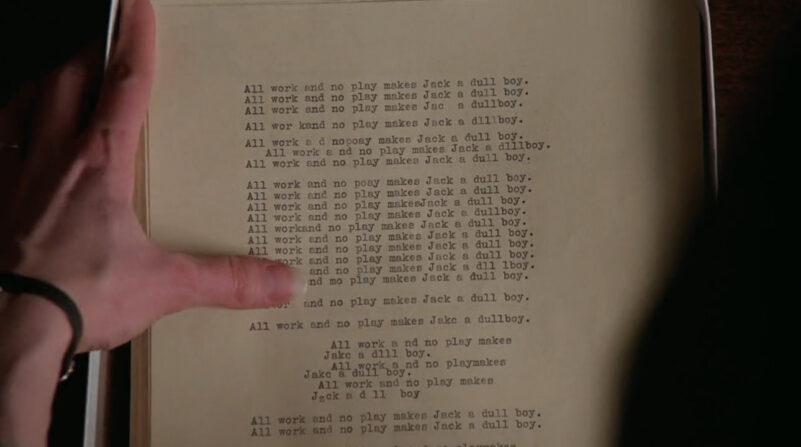
The Psychological Impact of Isolation
One of the most notable themes that courses through the narrative of The Shining is isolation and its psychological impact. The film transports the audience to the Overlook Hotel, a secluded edifice surrounded by vast expanses of snow, effectively cutting the Torrance family from the rest of the world. The theme of isolation begins with a physical separation but rapidly becomes psychological as Jack descends into madness.
This isolation has a dual role: it both exposes and fuels the madness lurking within Jack. With no one to interact with, his mind becomes an echo chamber for his fears, frustrations, and inner demons. As he is increasingly drawn into his own mind, the line between his perception and reality blurs, leading to paranoia and aggression. The remote setting of the hotel, combined with the long, harsh winter, intensifies the sense of claustrophobia and psychological pressure, slowly distorting Jack’s grasp on reality.
Wendy and Danny are not immune to the detrimental effects of isolation either. Wendy, distanced from any societal support and trapped with an increasingly volatile husband, is pushed into a state of fear and desperation. Her isolation heightens her vulnerability, leaving her defenseless in the face of her husband’s madness. Danny, likewise, is trapped in his own kind of isolation. His psychic abilities estrange him from his parents, making him privy to the looming dangers but unable to articulate or share them effectively. In their isolation, each family member grapples with their fears and vulnerabilities, pushing them towards an unavoidable tragedy.
The Duality of Human Nature
A central theme explored in The Shining is the duality of human nature. The film delves into this dichotomy, illustrating the coexistence of good and evil, sanity and madness, reality and illusion within the characters. Jack, initially presented as a flawed but well-meaning father, descends into a murderous frenzy, demonstrating the darker side that lurks beneath the surface.
Contrastingly, Danny, a young boy, showcases a paradoxical blend of innocence and wisdom far beyond his years, courtesy of his “shine” (a phenomena discussed in the Title Explanation section). His character exemplifies the capacity for good, purity, and resilience in the face of immense terror. Meanwhile, Wendy, an initially passive figure, summons her strength and determination to protect her son, illustrating the dual facets of vulnerability and strength.
The hotel itself mirrors this duality. It’s a beautiful architectural marvel, but it houses a terrifying history, becoming a character of its own with an exterior of grandeur and an interior of menace. This exploration of duality underscores the complexities and contradictions of human nature and our environments, demonstrating the coexistence of light and darkness in the same space.
The theme of duality in The Shining holds a mirror up to the larger society, demonstrating the dichotomy that exists within us all. Every individual possesses the capacity for both good and evil, strength and vulnerability, rationality and irrationality. We often see this duality manifest in society, in the form of differing beliefs, conflicting actions, and the continual struggle between progress and regress.
Just like Jack, society often faces the challenge of containing its darker tendencies. From acts of discrimination and violence to instances of corruption and greed, these are manifestations of society’s “dark side.” Similarly, like Wendy and Danny, society also has the capacity for resilience, compassion, and change. Acts of kindness, advocacy for justice, and collective initiatives for positive change are testament to this “light.”
The Overlook Hotel serves as a metaphor for society itself: beautiful yet haunted, welcoming yet dangerous. It houses within its walls the memories of joy and horror, much like societies that harbor histories of both progress and atrocities.
The Cycle of Violence
A third significant theme in The Shining is the cycle of violence. The Overlook Hotel stands as a haunting monument to a history of violence and malevolence. Throughout the narrative, we learn about its troubled past, which seems to linger and influence the present. The hotel’s violent history is unveiled through a series of horrifying revelations: stories of mobsters, murders, and a previous winter caretaker who, succumbing to cabin fever, killed his family before committing suicide. These snippets of the hotel’s past build a narrative of recurrent violence, creating a thematic cycle that echoes ominously through the corridors of the Overlook.
Jack, a recovering alcoholic with his own violent tendencies, becomes the latest link in this chain of violence. It’s as if the hotel seeks to repeat its bloody history through Jack, tapping into his existing vulnerabilities and exacerbating them. His hallucinations and interactions with the apparitions of the hotel indicate that he’s not just spiraling into madness in isolation; he’s being driven to it by the echoes of past violence that haunt the hotel.
This reflects a crucial aspect of the cycle of violence theme: the power of past atrocities to perpetuate and replicate themselves in the future. The violence in the Overlook Hotel’s history doesn’t just remain in the past—it actively seeps into the present, manipulating the inhabitants towards further violence. Jack’s journey from a flawed individual to a homicidal maniac under the hotel’s influence illustrates how past violence, when left unresolved or unacknowledged, can continue to wreak havoc on the present and the future.
However, the narrative doesn’t leave us bereft of hope. Through the characters of Wendy and Danny, it points towards a potential path to peace and reconciliation. Wendy’s journey, for instance, although fraught with terror, demonstrates an inspiring resilience and determination to protect her child. She represents the spirit of survival against oppressive violence. Wendy’s determination to escape the cycle of violence in the Overlook Hotel is the first step towards breaking it. Her actions suggest that courage, resolve, and a desire for safety can indeed challenge this recurrent pattern.
Danny’s role in breaking this cycle, however, is more nuanced. His shine makes him a passive observer of the hotel’s violent history, which he is unable to influence or change. Yet, he isn’t just a victim. Danny also exemplifies resilience, survival, and an intuitive understanding of the nature of the violence that surrounds him. Through his psychic abilities, he anticipates the threat posed by his father and effectively navigates through the dangers.
His ability to confront the past atrocities, symbolized by the terrifying apparitions in the hotel, and his capacity to survive the immediate violence threatening him signifies a form of reconciliation. By surviving the physical violence enacted upon his family and mentally navigating through the hotel’s violent past, Danny symbolically reconciles with the history and breaks free from its chain of repetition.
In the real world, such paths towards peace and reconciliation often involve acknowledging past atrocities, understanding the root causes of violence, ensuring accountability, and taking decisive steps to avoid the repetition of past mistakes. While the process is complex and challenging, it’s a necessary journey to prevent history from repeating itself in a destructive cycle of violence.
Why is the movie called The Shining?
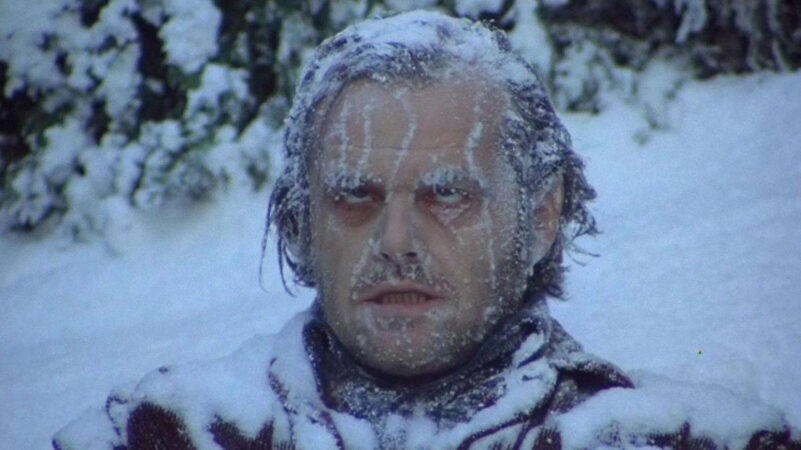
The Shining is a title that goes beyond the simplicity of its meaning, a dual-edged sword that carries profound connotations. It is a manifestation of the ethereal, hauntingly unspoken psychological and supernatural elements that pervade the story. The title refers to a supernatural ability, the “shine,” possessed by Danny, the young boy at the heart of the narrative. This shine allows him to tap into the unseen realities of time, place, and human consciousness. It also leaves him vulnerable to the horrifying undercurrents of the past, resonating in the desolate, eerie halls of the Overlook Hotel.
The notion of shining, however, extends beyond just the literal interpretation. The concept of shining speaks to the unseen light—or darkness—that resides within each of us. Jack does not possess the shine in the supernatural sense, but rather, his figurative shine represents his character trajectory—his slow descent into insanity driven by isolation, substance abuse, and perhaps the malevolent influence of the hotel. This metaphorical shine symbolizes his transformation from a flawed but seemingly loving father and husband into a figure of terror. His light isn’t the beacon of hope and warmth we associate with illumination, but a blinding, overwhelming intensity that drives him to destructive behavior. Jack’s shine can be viewed as an allegory for the internal struggle many face, a tormenting mental battle often hidden under the facade of normalcy.
There’s the darkness, now here’s the light: Danny’s shine is more than a psychic ability. It symbolizes a child’s innocence and intuition; a pureness being forced to grapple with darkness far beyond his tender years. His shine gives him insight, a window into the raw reality to which adults often blind themselves, both the past and the future. It also serves as a call to awaken, to see, and confront the cruel, often unseen realities that we have either chosen to ignore or unknowingly inherited.
The Overlook Hotel, too, has its own shine, albeit a malevolent one. It’s a structure imbued with the memories of past transgressions, a twisted mirroring of the broader human history. The hotel’s shine is the echo of the horrors committed within its walls, a never-ending cycle of violence that the Torrance family unwittingly steps into.
In a broader sense, Danny’s ability to shine serves as a potent metaphor for younger generations as they learn to grapple with the sins and evils of those that have come before them. His psychic ability not only allows him to perceive the literal ghosts that haunt the Overlook Hotel but also acts as a metaphorical bridge to the residual trauma and violence that the older generations have left in their wake. Danny’s shine thrusts him into the midst of past atrocities, forcing him to grapple with and navigate through horrors that he did not cause but must nonetheless endure. This mirrors how younger generations in our society are often burdened with the aftermath of their predecessors’ actions, whether these be wars, environmental degradation, systemic racism, or intergenerational trauma. The young are thrown into a world with existing structures and echoes of the past, carrying the weight of history, much like Danny.
But Danny’s shine also provides an insight into the need for understanding and empathy. Despite his tender age, he’s capable of seeing the complex layers of history, the darker corners of the human mind, and even the eventual redemption and forgiveness required to move beyond past sins. In a broader societal context, this could symbolize the need for younger generations to comprehend and learn from history, to empathize with different experiences, and to strive for change and healing.
Danny’s survival despite his harrowing ordeal speaks to the resilience of the younger generation. He’s traumatized but not defeated, reflecting the hope and strength that lies within the young, their ability to confront, endure, and perhaps eventually overcome the evils and sins of the past.
Thus, The Shining encapsulates the duality of illumination. It embodies both the enlightening radiance that can guide us and the blinding, consuming glare that can lead us astray. In essence, the film uses the concept of shine as a powerful metaphor for the underlying human experiences, the innate psychic connection we share with the world, the latent darkness within us, and the lingering echoes of history. It is an in-depth exploration of how we confront these, how we navigate through our own labyrinth of existence, and how we eventually come to terms with our own shine. It is not just a title—it is a profound reflection on the enigmatic complexity of human nature and existence.
Important motifs in The Shining
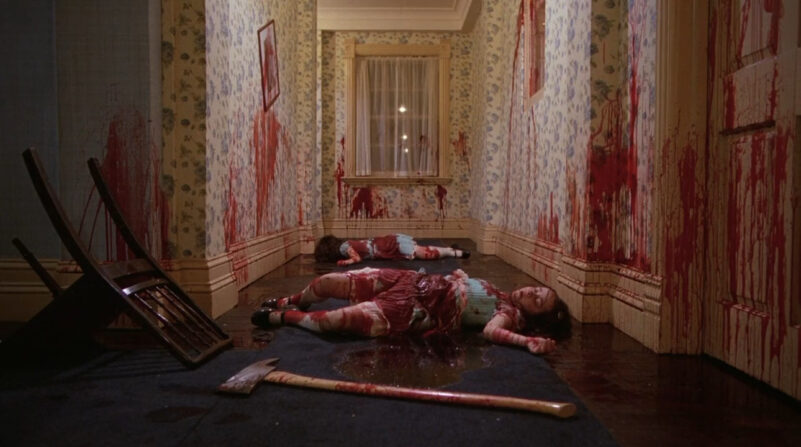
The Overlook Hotel
The Overlook Hotel itself is a powerful motif in The Shining, representing a labyrinth of the past, filled with echos of historical violence (a theme discussed in the Themes and Meaning section). It serves as a mirror for Jack’s descent into madness, its long, winding corridors paralleling his spiral into insanity. The hotel also serves as a stage for confronting past atrocities. Its spaces—the ballroom, Room 237, the Gold Room—become sites where characters encounter the past, embodied in eerie apparitions and unsettling visions. The hotel’s persistent influence, despite seasonal closure and geographical isolation, underscores its symbolic status as a reservoir of inherited violence and historical trauma.
The Maze
The maze motif, both literal and metaphorical (as discussed in the Ending Explained section), plays a crucial role in the narrative. On the surface, the hotel’s hedge maze is a structure for children’s games and exploration. But as the story unfolds, it becomes a symbol for confusion, fear, and survival. Metaphorically, the hotel itself is a maze, filled with corridors of past violence and haunting memories. The characters must navigate these twin labyrinths—one physical and the other psychological—illustrating their journey through and escape from the terrifying legacy of violence that engulfs the Overlook Hotel.
Mirrors
Mirrors and reflections feature prominently in The Shining. Often used to reveal an altered reality, they highlight the duality of human nature and the tension between appearance and reality. The film frequently uses mirror images to indicate a shift from normalcy to horror. Jack’s conversations with apparitions often occur with mirrors present, symbolizing his gradual alignment with the hotel’s violent history. Similarly, the word “redrum” must be seen in a mirror to reveal its true, chilling meaning: “murder”. These mirrors reflect the characters’ altered states, the intrusion of past into present, and the thin veil separating sanity from madness.
The Number 237
The number 237, specifically relating to Room 237, is a recurring motif that holds an ominous presence. It’s the epicenter of the hotel’s malevolence, and the source of fear and fascination for Danny. This room represents the heart of the hotel’s past atrocities, embodying its violent history. It’s in Room 237 that Jack fully succumbs to the hotel’s influence, signaling his complete descent into madness. The number 237 becomes synonymous with the unknown and forbidden, illustrating the allure and danger of delving into the murky depths of the past.
The Twins
The ghostly apparitions of the Grady twins are a recurring and chilling motif. They embody the hotel’s violent past, representing victims of the cycle of violence that has marked the Overlook’s history. The twins’ pleas for Danny to “play with them forever” can be seen as a sinister invitation to join this cycle. Their presence emphasizes the film’s exploration of inherited violence, highlighting the impact on younger generations who are confronted with the sins and evils of their predecessors. These apparitions of the past constantly intrude into the present, creating an unsettling atmosphere and reinforcing the haunting power of history.
Questions & answers about The Shining
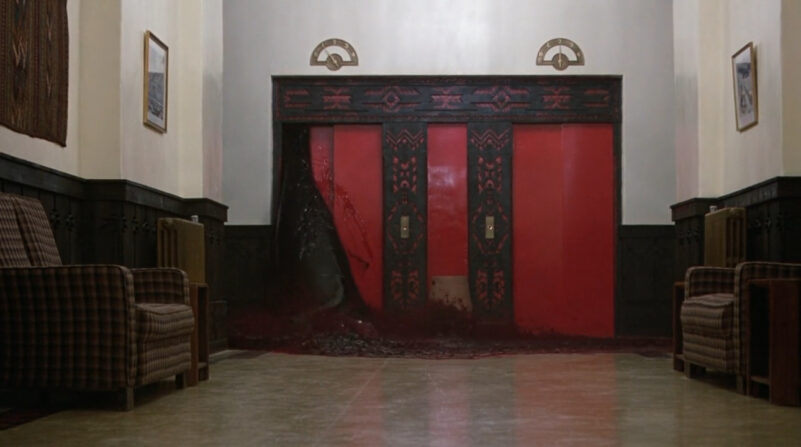
What is “shining”?
“Shining” is a psychic ability that Danny possesses, allowing him to read minds, see visions of the past and future, and communicate telepathically. This supernatural ability introduces an essential layer of understanding to The Shining, connecting the present inhabitants of the Overlook Hotel with its violent history. Danny’s gift symbolizes the sensitivity of some individuals, particularly children, to the influence and residual effects of past violence.
Understanding shining is crucial for grasping the movie’s exploration of generational trauma and the haunting legacy of the past. The ability to shine essentially bridges the gap between past, present, and future, allowing the story to explore the cyclical nature of violence, the lingering impact of historical trauma, and the necessity of breaking these harmful cycles.
What does the blood flooding the hallway symbolize?
The recurring vision of blood flooding the hallway from the elevator is one of the most iconic and disturbing images in The Shining. The image symbolizes the Overlook Hotel’s brutal and violent past. The enormous amount of blood could represent the numerous lives taken in the hotel, and the way it gushes out suggests the uncontainable and overwhelming nature of this violence. Its appearance to Danny, and later Wendy, serves as a stark warning of the impending danger.
Understanding this vision is crucial to grasping the cycle of violence theme in the film. It suggests that past actions are not easily forgotten or erased. Instead, they linger, impacting future events and individuals who were not even present when the original violence occurred. This indicates how the past’s destructive patterns can continue to exert their influence unless consciously confronted and broken.
What’s the significance of the dead woman in the bathtub?
The apparition of the dead woman in the bathtub in Room 237 is one of the movie’s most haunting images. She symbolizes the decadence and decay hiding beneath the Overlook’s luxurious facade. She is first seen as a beautiful, young woman, luring in the unsuspecting victim, much like the hotel itself. Her transformation into a rotting corpse mirrors the hidden ugliness and malevolence of the hotel.
Her manifestation underscores the danger of being deceived by surface appearances, reinforcing the film’s theme of duality and deception. It’s a chilling lesson for Danny and a warning for the viewers about the lurking horrors within the Overlook Hotel.
What is the significance of Danny chanting “redrum”?
Danny chanting “redrum” represents his struggle with the terrifying visions he’s experiencing and his attempt to communicate these threats. The word “redrum,” when viewed in a mirror, reveals its true meaning: “murder.” This revelation underscores the film’s exploration of mirrors and reflections as motifs of truth and revelation.
Danny’s chant is an ominous foreshadowing of the impending violence, primarily driven by his father. It signifies his shining ability revealing the dark intentions that have been inverted and hidden from plain view, much like the reflected word itself.
Why did Danny dissociate and let Tony take over his body?
Danny’s dissociation and the emergence of Tony, his imaginary friend, suggest a coping mechanism against the extreme trauma and fear he is experiencing at the Overlook Hotel. Tony serves as a protective entity, providing Danny with a way to distance himself from the terrifying reality unfolding around him.
Understanding this dynamic offers insights into the profound psychological impact of fear and trauma, particularly on a child’s mind. It echoes the theme of duality in the film—Tony as Danny’s alter ego—and signifies the desperate measures one might resort to in order to preserve their sanity in the face of terror.
Now it’s your turn
Have more unanswered questions about The Shining? Are there themes or motifs we missed? Is there more to explain about the ending? Please post your questions and thoughts in the comments section! We’ll do our best to address every one of them. If we like what you have to say, you could become part of our movie guide!

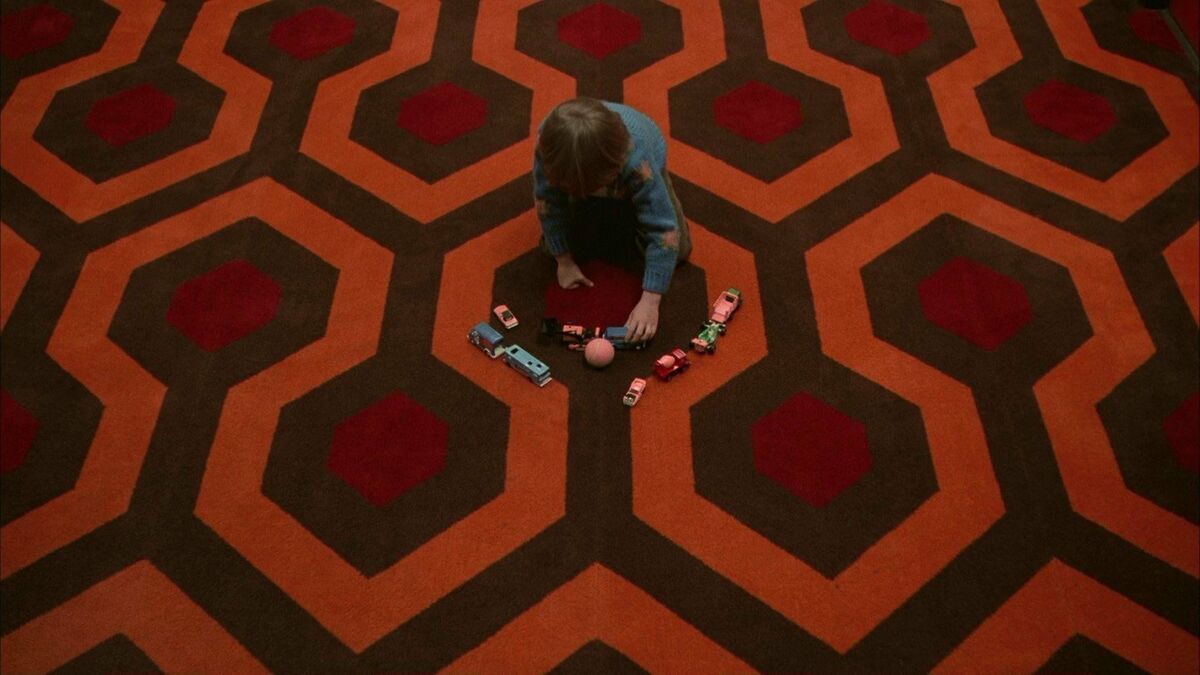
Hi
I like what you have written about the shining. It’s such a rich film with powerful imagery and depths that it could be analysed forever.
I want to briefly add something to the maze interpretation that I think is being explored.
I think the maze is key to the survival of Danny in Wendy, the scene in which Jack towers over the model of the maze while Wendy and Danny navigate it says to me that Wendy and Danny are navigating their way through their past traumas and feelings. They encounter dead ends together, explore together and navigate their way out together. This togetherness is in direct opposition to Jack’s isolation meaning he cannot resolve his inner anger and trauma response and so turns to self medication, addiction and blaming everyone else around him. Navigating the maze with human connection, support and empathy is the only way to break the cycle of violence or else you are doomed to repeat it.
I think this also ties into the Jungian philosophy hinted at with the red book being present at the interview scene.
Thanks for a great and interesting resource
Stu